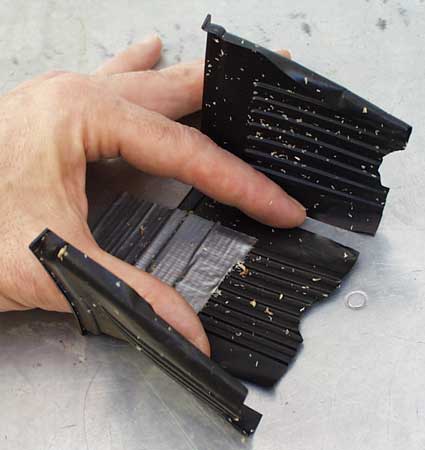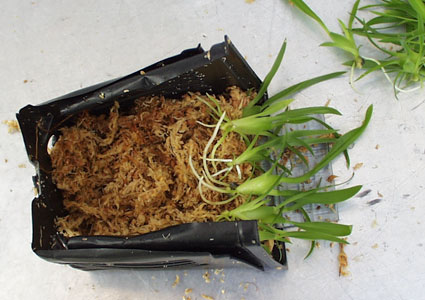Our Compotting Method
To make the plants easier to separate later, and to give each good contact with the sphagnum, we place each seedling individually while making the compot. While at first look this seems quite labor-intensive, the results are good, and with practice and some tools it actually can be quite quick, though not as quick as just plopping them all in a pot.
Tools
The potting jig we use is made out of a couple of pots of the same kind that we pot into. Figure 1 shows a pot and the two parts of the jig which were made out of pots. The part on the left is the inner part of the jig, and it is a pot with one side and the bottom cut out of it. It also has a duct-tape tab affixed on the edge which is used as a handle in the process. The jig part on the right is a pot with only one side cut out. The bottom remains in this one, and it acts as the sturdy outer part of the jig.
|

Figure 1: Pot and Two-Part Jig
|
The Inner Jig
The inner part of the jig is used to transfer the "plug" of the plants and sphagnum into the destination pot. It must be able to be inserted into the pot with the plug, but then pulled back out, leaving the plug in the pot, without dragging any of the medium back out with it. This is why it doesn't have a bottom, but beyond that, it must be slit up the sides so that it can expand in the tapered pot, and any features that might hang up on the medium must also be removed, such as in this case, the angled areas where the drain holes used to be. Figure 2 shows the inside jig spread open just to reveal these features.
|

Figure 2: Cutting Detail of Inner Jig
|
The Assembled Jig
The two parts of the jig, put together and ready for use, are shown in Figure 3.
|

Figure 3: Two-Part Jig Ready for Use
|
Using the Jig: The First Layer
A layer of soaked, wrung-out sphagnum should be laid in the bottom of the jig, which is equivalent to the side of the pot. If you are going to plant many plants in the pot, then a thin layer should be placed, or thicker if fewer plants. This is shown in Figure 4.
|

Figure 4: First Layer of Sphagnum
|
First Row of Plants
Place a line of plants on top of the sphagnum layer, roots and base on the sphagnum, and the tops of the plants extending out of the open mouth of the jig. Put only a few plants if they are large, or more if small. This is shown in Figure 5.
|

Figure 5: First Row of Plants
|
Covering the Base of the Plants
The next step is to add another layer of sphagnum, but if some care is taken to cover the base of the row of plants with a few long strips of sphagnum, this makes for a very much neater and more uniform surface when the potting is completed. This is shown in Figure 6.
|

Figure 6: Covering Plant Bases with Long Strips of Sphagnum
|
The Next Layer of Sphagnum
In Figure 7 the rest of the layer of sphagnum has been added from the base of the plants to the back of the jig.
|

Figure 7: Finished Layer of Sphagnum
|
The Next Layer of Plants
In Figure 8 another layer of plants has been added.
|

Figure 8: Second Layer of Plants
|
Keep Building Layers
Continue to repeat layers of sphagnum and plants until you run out of plants or pot space.
|

Figure 9: Final Layer of Plants
|
The Last Layer of Sphagnum
In Figure 10 the last of the layer of sphagnum has been added to fill the jig up to the top. Enough is added to make the plug fairly firmly packed, and it should spring back up out of the jig a little.
|

Figure 10: Final Layer of Sphagnum
|
Removal from Outer Part of Jig
The inner part of the jig is now removed from the outer part, which has been giving it mechanical support and providing a back wall (bottom of the pot) to build the layers against. See Figure 11.
|

Figure 11: Removal of Inner Jig
|
Insertion into Pot
Now the inner part of the jig is inserted, still tilted sideways, into the destination pot. See Figure 12.
|

Figure 12: Insertion of Inner Jig into Pot
|
Pot Upright
At this point the pot and plants are finally set upright. See Figure 13.
|

Figure 13: Pot Upright
|
Removal of Inner Jig
Using a couple of fingers on the surface of the sphagnum to keep the plug in place in the pot, withdraw the inner jig part from the pot by pulling upward on the tab handle. See Figure 14.
|

Figure 14: Removal of Inner Jig from Pot
|
Snugging and Labeling
With the inner jig part removed, the sphagnum and plants should be gently snugged down into the pot around the edges and perhaps between a few of the more central plants. Every pot should be labeled, and we recommend that at a minimum each tag should state the species of the plant, the TN Number, the Flask Number and the date potted. See Figure 15.
|

Figure 15: Completed Pot with Label
|